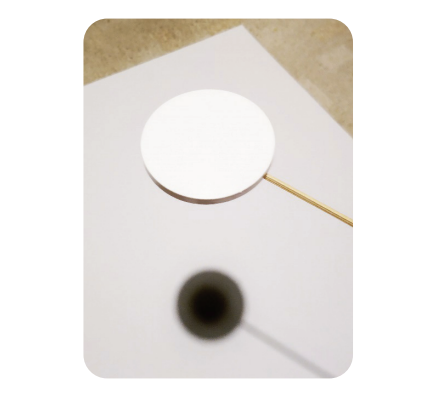- Practical Exercise 1 DEMONSTRATION OF A SOLAR ECLIPSE
- Practical Exercise 2 SOLAR ECLIPSE MODEL IN THE FIELD
- Practical Exercise 3 APPARENT SIZE OF THE SUN AND MOON IN THE SKY – TYPES OF SOLAR ECLIPSES
- Practical Exercise 4 OBSERVATION OF A TOTAL SOLAR ECLIPSE FROM OTHER PLANETS
- Practical Exercise 5 THE NEAREST SOLAR ECLIPSES
Practical Exercise 1: DEMONSTRATION OF A SOLAR ECLIPSE
Demonstrate the solar eclipse in a darkened room. Use a weaker directional planar light source as the Sun model. Use different sized spheres (balls) as models of the Earth and the Moon, keeping true to the ratio of sizes – the Moon is about 3 to 4 times smaller in diameter than the Earth. Illuminate the Earth model with light, place the “Moon” at a suitable distance between the “Sun” and the “Earth” and observe the formation of full shadow and half-shadow on the “Earth’s” surface.
Objective of Practical Exercise
The aim of this activity is for pupils to understand the principle of solar eclipse and areas of full shadow and half-shadow. They will remember the relative position of the bodies during the solar eclipse (Sun – Moon – Earth) in this particular order.
Methodical notes for the teacher
• The biggest problem is securing a suitable light source. The source must be planar, ideally circular, with a diameter of at least 20 cm, preferably 30 and more cm. At the same time, the source must be directional so as not to illuminate the surroundings of the room, but only shine on “Earth” and “Moon”. It is advisable for the source to be relatively weak (20 – 40 W bulb at a distance of 2 – 3 meters) so that the room is not irradiated by light reflected from the models. A reflector with a narrow cone with a diameter of 30 – 40 cm is ideal. It is also possible to use a larger hanging ceiling lamp (chandelier) wrapped on the sides and at the top with a cone of opaque fabric (for example, a thicker jacket, sweatshirt or sweater buttoned down and thrown over the chandelier). Then, of course, the optical axis of the experiment is oriented vertically and the "Earth” lies on the floor under the chandelier.

• For implementation, it would be ideal to have a room with black walls absorbing scattered and reflected light. Then the restrictions placed on the light source would not have to be so strict. (The Sun is also an omnidirectional source.) However, such a room is generally not available.
• It is advisable not to hold the Moon model in your hand, but to place it on a stick so that it does not disturb the shadow of the fingers in the projected shadow and half-shadow.
• Suitable models are, for example, volleyball – Earth and tennis ball – Moon; possibly foam or gymnastic ball 15 cm – Earth and table tennis ball – Moon.
• If suitable spherical body models are not available, the shadow and half-shadow can be projected on a flat surface using a circular shade, see the figure beside the text. The shadow and half-shadow areas are still clearly visible, but the model already partially loses the impression of reality.
• The most important thing is to prepare a suitable light source and a good blackout of the room. We recommend preparing and trying this out in advance, not leaving it to the pupils' activities.
Sample answer:
This is a qualitative activity; it is not possible or appropriate to provide a model solution. The specific design depends on the available options of the implementer, see notes above.


